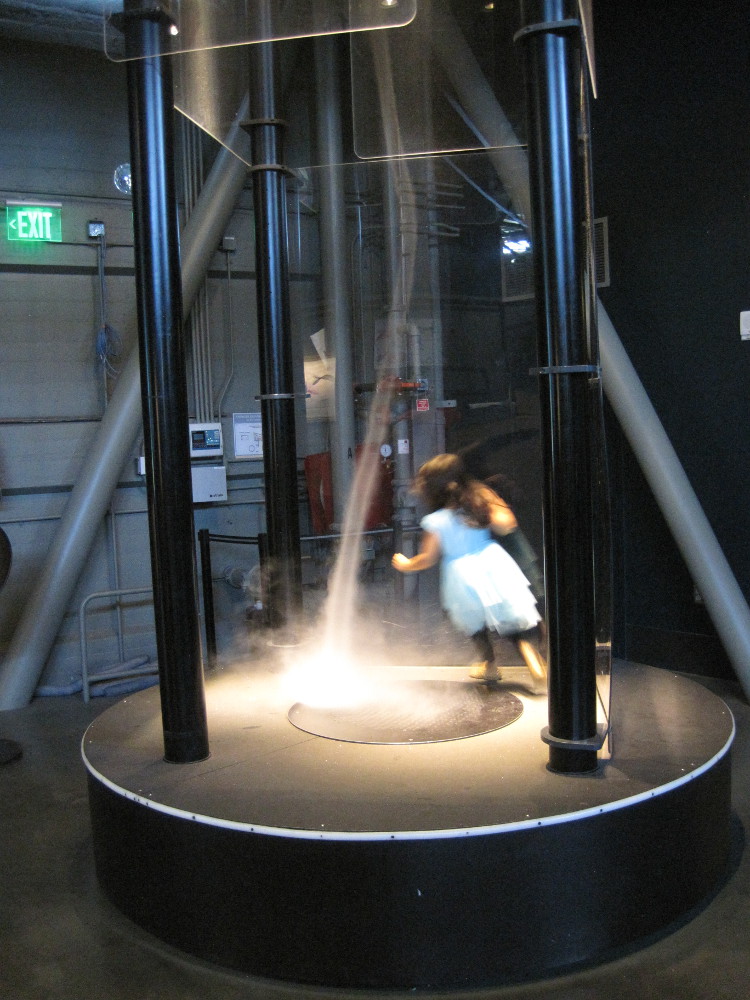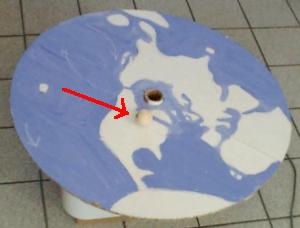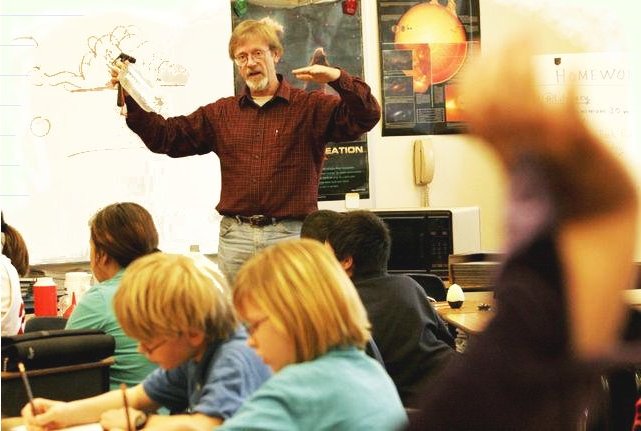
[Also see: Weather, and fog in a bottle]
To make a tornado, you need a few ingredients: (1) a strong updraft (2) something
to start the rotating action and (3) plenty of available energy.
In the summer in the central US, warm moist air flows up
from the gulf of Mexico. At the same time, colder air flows from the North, and slides
over the top of the warm air. Warm air at the bottom, cold air on top - this is not
stable. So masses of warm air rise, and these upward surges can turn into massive
thunderstorms. So here we have the strong updrafts. Where the air masses slide over
each other, tubes of rolling air can form, as the air on top goes in one direction,
and the air below goes in the opposite direction. When such a tube of rolling air
gets caught in an updraft, one end can be pulled up, and the other end can descend
below the bottom of the tunderstorm cloud. In the photo on the right
(from here), you can see both: a tornado descending, and a rolling tube.
|

These conditions are most common in the areas shown in dark colors on this map
(from here).
Notice that mountains, both in the east and the west, break up this inverted
layering, and therfore there are no tornados where we live, in Santa Fe, NM.
|
 To explain things, I made a tornado machine to show that rising air, combined
with some rotation, will self-organize into a vortex, which on a small of course
scale looks more like a tornado than a hurricane. The tornado in the box is 4 feet tall.
To explain things, I made a tornado machine to show that rising air, combined
with some rotation, will self-organize into a vortex, which on a small of course
scale looks more like a tornado than a hurricane. The tornado in the box is 4 feet tall.
Bigger →
Here is an interesting observation: look at the water in the pie pan
when there is no dry ice. The tornado is still there, but you can't see
it. However, the pressure in the center of the tornado where it touches
the surface of the water is so low that it raises a small dimple one the
surface to a height of 2-3 mm. This bump of water scoots around the
surface.
I made a movie of it here.
In the clip, you can see the bump, and dust in and on the water slowly
turning. I break up the vortex with my hand, and you see it re-establish
itself quickly.
 ← Bigger
← Bigger
Links:

| In the
Exploratorium
in San Francisco, there is a large tornado box.
There is a big fan on top sucking air upwards, and a vapor maker under the
floor grating, but nothing to start the air turning. You have to step up into it,
and run around until the tornado forms. How cool is that!
Bring:
- Tornado box (plus tube)
- Box fan
- Lights
- (grounded) extension cord
- Dry ice, gloves, hammer
- Pie pan
- Tape, rubber bands
- Cooler with extra insulation
|
.. and for stand-alone
- Water boiler
- Large water container
- Funnel
- 3-way grounded splitter
|
|
|
yearly since 2005
|
[Also see: Weather, and fog in a bottle]
The year 2005 had the most extreme hurricane season on record, with Katrina
devatating New Orleans, and the National Hurrican Center running out of names,
the first hurricane in history hitting Spain and Portugal, and hurricane
Epsilon still active past the official end of the hurricane season. Naturally there
were some questions about hurricanes.
 The second thing to explain is why hurricanes rotate in the first place, and why
they go counterclockwise in the Northern Hemispere and clockwise in the Southern
hemispere. For this purpose I made a flat rotating earth (hey, if Intelligent
Design can be
called 'science', I can claim that the earth is flat), so that I could show
that a rolling ball on a rotating disk does not follow a straight ground path,
but curves to the right in the Northern hemisphere.
Here's how to make this turntable.
The second thing to explain is why hurricanes rotate in the first place, and why
they go counterclockwise in the Northern Hemispere and clockwise in the Southern
hemispere. For this purpose I made a flat rotating earth (hey, if Intelligent
Design can be
called 'science', I can claim that the earth is flat), so that I could show
that a rolling ball on a rotating disk does not follow a straight ground path,
but curves to the right in the Northern hemisphere.
Here's how to make this turntable.
2005, Feb 2011
|
 February 98: Where do all the animals come from?
Time for a break from all the space stuff. There had been some
other vague questions about animals and plants, so here was an
opportunity to talk about evolution, one of the great pillars of science
that the kids should be familiar with.
February 98: Where do all the animals come from?
Time for a break from all the space stuff. There had been some
other vague questions about animals and plants, so here was an
opportunity to talk about evolution, one of the great pillars of science
that the kids should be familiar with.
I decided to make up a game
that could be played in class that would show evolutionary pressure,
drift, divergence and all that good stuff. Here is how it went:
First I set the scene: We have a small green valley, with brush, trees and
grass, all drawn on the board, and we are going to play at being these
medium-sized herbivores. They live for 4 years, then they die.
|
To make it easier for the children to keep track of their 'age',
I folded colored sheets in four, and marked quarters with large numbers
1-4, so that they could fold the right number out. Each 'live' animal
gets to hold one. |
In the first phase of
the game, we're basically going to populate the imaginary valley
up to the limit of the food supply, and follow the population for a while.
Each time we turn over a year, all live animals turn a year older,
and get to multiply - that is, pick another kid to join the herd, who
starts off at age 1. Those who turn 5, die and leave the herd. The valley
can support 14 (that's how many age-cards I made). Of course it takes
only 4 generations to saturate the food supply, after which the
new-member rate equals the death rate. This gets pretty boring after a
few rounds, but it shows that a population will fill an unoccupied
environmental niche, and then becomes resource-limited.
In the next phase, we're going to throw in some random
variation. In addition to the age-cards, I had made up 14 simple tape
measures
|
Colored 8.5x11 sheets from the recycling, cut into 4 lengthwise strips.
Tape 7 different colored strips end-to-end, fold them up and hold them
together with a clothes pin. Unfold as many strips as you need 'feet',
and put the clothespin back on the rest.
|
The 'live' animals each get a tape measure so
they can keep track of how tall they are. They all start out at 3', so
they can eat the shrubbery, but cannot reach the leaves on the trees. Now,
every time someone gets to pick an offspring, they get to roll a die;
I had some 8-sided dice, and made the following assignments:
- throw 1-2: offspring is 1' shorter than the parent
- throw 3-6: offspring is the same length as the parent
- throw 7-8: offspring is 1' taller than the parent
|
After a few rounds/years, the population is still mostly 3', but there
are now a few tall and short members.
Then evolutionary pressure strikes: the climate in our
little valley changes, and it turns into a a plain with a little grass
and trees, but no more brush. There is not enough food for the medium-sized
brush eaters, and they die off. The taller animals get to munch on the
trees, and a few of the smallest animals get to survive on the grass.
After a few rounds/years/generations it becomes clear that we now have
two different types of animals where we started with one type. Just
throwing the dice and some environmental pressure led to emergence of new
species. That's just about all we got done in one hour. The next
week, I reviewed the game, and put the proper names to various
things we had done. While we were playing the game the week before,
I had had no time to introduce the terminology ('evolution', 'survival of
the fittest' etc.), or any of the names (Darwin, Wallace). By coincidence,
I had just received the Feb 98 issue of Scientific American, in which
there was an article about the emergence of antibiotic resistance - a
prime example of evolution in real-time action in our world, and I used
that to stress that evolution is not just a thing of the past. Also, that
under current circumstances, that the human race can no longer evolve.
Of course, while we were on the subject, I had to mention DNA,
stepping down in scale from my fingertip to cells, then nuclei and
finally DNA. I had made up some new covers for a set of paperback books
of various thicknesses, a fat one titled 'How to make a Person', an
equally thick volume 'How to make a Monkey', a thinner one 'How to make
a Frog, and a single sheet titled 'How to make Bacteria'. These codebooks
are supposed to be written with only the letters C,G,T and A. Another
important point about these codebooks is that they contain many almost
identical chapters and pages between them, even between the 'Person' code
and the 'Bacteria' code. (Feb 16 98)
Finally, a collection
of related links:
-
Charles Darwin. The text of his works: 'The voyage of the Beagle',
'The origin of the species', and 'the Descent of Man'.
-
Charles Darwin. This is a short biography.
-
From single cells
to
monkeys in a few clicks of the mouse.
-
Evolution Entrance.
Some historical context, and links to other relevant scientists.
-
The World of Richard Dawkins. Miscellaneous interesting links here.
-
The Origin Of Life.
The BIG picture: the origin of the universe, the earth and life,
illustrated, no less.
-
The WWW Virtual Library: Evolution. Lotsa links at Harvard.
-
Science Links,
to biology, K-12 classroom activities, more.
-
Evolution Resources: visit the Galapagos Islands.
-
Evolution Resources from General Biology Texts
-
City Honors Evolution Reference Page
-
Paleontology, Fossils
-
Pro-Evolution/Anti-Creationism Resources - Links Page
-
Science Bookmarks
-
Illustrations of the workings of DNA.
-
The electronic zoo
|




 February 98: Where do all the animals come from?
Time for a break from all the space stuff. There had been some
other vague questions about animals and plants, so here was an
opportunity to talk about evolution, one of the great pillars of science
that the kids should be familiar with.
February 98: Where do all the animals come from?
Time for a break from all the space stuff. There had been some
other vague questions about animals and plants, so here was an
opportunity to talk about evolution, one of the great pillars of science
that the kids should be familiar with. 



 ←
←  The second thing to explain is why hurricanes rotate in the first place, and why
they go counterclockwise in the Northern Hemispere and clockwise in the Southern
hemispere. For this purpose I made a flat rotating earth (hey, if Intelligent
Design can be
called 'science', I can claim that the earth is flat), so that I could show
that a rolling ball on a rotating disk does not follow a straight ground path,
but curves to the right in the Northern hemisphere.
The second thing to explain is why hurricanes rotate in the first place, and why
they go counterclockwise in the Northern Hemispere and clockwise in the Southern
hemispere. For this purpose I made a flat rotating earth (hey, if Intelligent
Design can be
called 'science', I can claim that the earth is flat), so that I could show
that a rolling ball on a rotating disk does not follow a straight ground path,
but curves to the right in the Northern hemisphere.